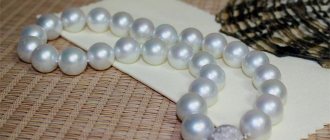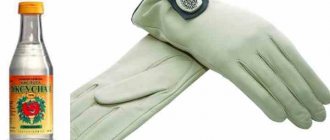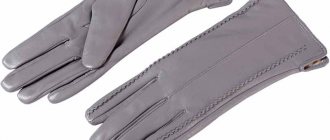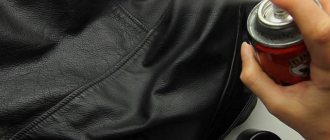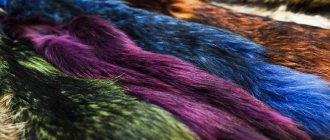A mink coat is without a doubt one of the “girls’ best friends.” Despite the ardent indignation of nature lovers and animal defenders, a woman looks chic in natural fur. How to properly store a mink coat so that it remains beautiful and warm for all ten seasons for which a mink is on average designed?
A mink coat is beautiful and warm. How to store it in winter and summer, read our article
For obvious reasons, storage of fur products can be divided into two states: current - during the cold period when you wear them, and long-term, when you send your furs for “preservation”. In this article we will look in detail at the subtleties and nuances of storage, but first, a little theory, from which all subsequent practical advice follows.
How to store a fur coat: simple secrets
There are several simple secrets and recommendations on how to preserve a mink product until the next season so that it does not lose its neat appearance or wear out.
Preparing a fur product
If you are looking for a way to properly store a mink coat at home, then you must initially devote time to properly preparing the product.
Thoroughly clean the product from dust and dirt. To do this, shake it vigorously several times, and then walk with a special brush both on the outside and on the inside.
If the mink surface needs to be cleaned of grease, use available means for this: talc, starch or flour. They are good absorbents and quickly absorb excess fat.
It will be enough to apply the loose product for half an hour, then shake off or sweep away with a soft brush. To prevent contamination, take your mink items to the dry cleaner at least once a year.
After cleaning the fur, the mink item must be well ventilated and dried. To do this, hang the fur coat on hangers and leave it for several days in a dark, cool room with good air circulation. It is better to choose a wooden hanger that is suitable in size so that the sleeves do not become deformed during storage.
Finally, fasten the buttons and pockets, remove the accessories and place the mink item in the case.
Choosing a good case
Owners often face the question of which case to keep their mink coat in. First of all, when choosing, you should pay attention to the material; it should allow air to pass through well. Cotton and linen sheaths cope with this: they create an air layer around the fur coat and preserve the fur qualities.
Plastic bags are absolutely not suitable.
It is also recommended to choose a dark-colored cover, preferably black, or blue for a light fur coat. In addition, the material of the case should not be painted.
Summer storage
When the cold season ends, you need to decide how to store a mink coat in the summer at home. First you need to choose the right storage location. A spacious closet or dressing room is suitable for this.
To avoid creases and abrasions of fur, the product should not come into contact with other things. Then take care of the correct temperature in the room: the air should be cool (the best option is from 0 to +10ºС), and the humidity should be within 45%.
To prevent the fur from fading, it is necessary to avoid direct sunlight. The storage location should be well ventilated, and once every 2-3 months, take the mink coat for several hours closer to the windows or to the balcony for ventilation.
If you do not dare to keep a fur coat at home, place it in a special freezer, where the required temperature is maintained and other rules for storing mink products are observed. Many dry cleaners offer this service in the summer. To the question of whether it is possible to store a fur coat in a home freezer, the answer is negative; A food freezer is not suitable for this purpose.
Storing mink fur products in winter
There are several rules for caring for fur in winter. Firstly, it is necessary to dry the mink coat well after each wear, since high humidity has a negative effect on the condition of the fur. Do this at room temperature, away from heaters and radiators.
Secondly, the mink product must “breathe”. If due to weather conditions it is not possible to go outside, you can hang it on the balcony; in winter, choose clear frosty days for this. Under no circumstances should you permanently store a mink item on the balcony: it will become damp and lose its attractive appearance.
You should also adhere to simple rules for using a mink product: do not wear a bag on your shoulder, but on the collar of accessories. Because of this, over time, the lint falls out and bald spots form on the surface.
Winter: wearing rules...
Mink is capricious to wear and does not tolerate neglect. For a fur coat to remain beautiful for more than one season, it must be worn correctly. And here’s what you should pay attention to before “walking” your pet.
- Freezing. Mink loves low temperatures. Therefore, a frosty day is a great reason to take a walk in your favorite fur outfit.
- Sun. Bright sun causes the color to fade. It should be avoided so that the fur does not lose its luxurious color.
- Moisture. What happens to your hair after it rains? Same as with fur. If you suddenly get caught in wet snow, get to a warm room as soon as possible, shake off the moisture and dry your fur coat at room temperature. You can’t use a hairdryer - it will dry out the pile and leather fabric.
- Dust. Dust settles on the hairs, gets clogged into the pores of the leather fabric - the fur coat quickly loses its luster and looks untidy. If it’s already frosty, but there’s not enough snow outside, and the wind raises clouds of dust, leave your fur coat at home until better times.
- Friction. It is a nightmare for a fur coat. Even with slight but prolonged pressure, the fur wrinkles. And with constant friction, it’s even worse: the guard hair breaks, the underhair gets wiped out, and ugly bald patches appear. Therefore: we carry bags exclusively in our hands and diligently avoid crowds.
- Reagents. Mink fur is very delicate and does not tolerate exposure to aggressive substances. It is better not to walk along streets treated with reagents in a long fur coat: the route should be from the entrance to the transport and back.
Storage rules
Compliance with the storage standards for mink coats is necessary to preserve the shape and appearance of the product.
Sufficient space
An extensive dressing room and a cool hallway are excellent options for storing a mink coat. But the closet where the fur coat is placed on a hanger must be spacious. This allows the leather and fur of fine clothing to “breathe.”
If the space is full of things, then it is better to free it up for a mink, finding another storage for other clothes.
A mink coat should be stored on a wooden hanger with wide shoulders that can support its weight, while avoiding unwanted folds on the product, damage to the lining and deformation of the sleeves.
Lack of light
To preserve the mink, a dark place is necessary. Fur does not tolerate exposure to direct sunlight. Therefore, the cabinet should not be illuminated by the sun. You should not place it near or opposite a window.
The best options for storing storage are the hallway, the first floor of your own house near the air conditioner.
Temperature
Mink fur loves cold storage; the temperature should not be high (no more than + 10...+15 C). You should not hang such a coat near heaters.
Avoid storing fur products in damp places. Humidity above 50% is harmful to fur. It may be a good idea to have a dehumidifier in the room where the fur will be stored, especially in areas prone to high humidity. But there is a danger of drying out the product, since its material is not only fur, but also leather.
It is more difficult to store a fur coat in the summer. You should find a space in the house where it is not so hot. You can place it in the basement of your own home, but be sure to monitor the readings of the thermometer and hygrometer.
However, it is difficult to maintain a safe level of heat and humidity even with air conditioning, so occasionally in cloudy weather you need to hang your fur coat on the balcony, avoiding moisture on the fur.
No unnecessary accessories
Before hanging mink clothing in the closet, all buttons, metal buckles, and hooks must be well attached to the product and fastened.
We recommend: How to properly store beets? storage methods
Other accessories: brooches, pins, pendants, chains, keychains must be removed. They should not be pinned at all unless this is provided by the manufacturer.
Case
A special case for storing a fur coat is most often sold along with it. It is made from lightweight, breathable fabric. It is generally accepted to impregnate it with protective agents against moths. A plastic cover cannot be used: the fur dries out due to lack of air.
When purchasing or making in a studio, pay attention to the length and width of the cover, which should be 10-15 larger than the size of the fur coat. The right storage has a side insert in a cover that prevents the fur coat from shrinking.
You can preserve a mink coat by wrapping it in a dark cotton cloth (such as thick linen), carefully tying it at the bottom and top. But the clothes in this makeshift storage unit shouldn't wrinkle.
Features of protection against moths
To protect a mink coat from moths, it is placed in covers with special impregnation or anti-moth preparations (Armol, Raptor, Antimol) are used in the form of granules placed in pockets. Granules absorb moisture, which is also not very good for fur. It can also be difficult to get rid of the smell of some anti-moth products.
It is important to consider that the preparations are changed every 3-4 months, and anti-moth aerosols and sprays are used only for the cover, but not for the fur.
Since ancient times, housewives have put aromatic herbs into the sleeves and pockets of fur coats as protection against pests: geranium, lavender, patchouli, thyme, as well as orange and lemon peels.
Old recommendations suggest airing and shaking mink fur more often. Aired and clean fur coats are wrapped in a linen bag, which is pre-soaked for 12 hours in a concentrated solution of salt and laundry soap. After drying, it is steamed with a hot iron.
Case or vacuum bag?
A fur coat needs a cover in any case. It is not recommended to store either a separate product without a cover, much less furs of different colors: the coloring material from one of them can be imprinted on the other.
The safety of a fur coat depends not only on temperature conditions and humidity, but also on the quality of the cover in which it is placed. When choosing it, you need to take into account a number of nuances:
The width of the cover should not be less than the width of the product
Also pay attention to the length. It should be 10–15 cm larger than the size of the fur coat
This is necessary to ensure that the clothes do not wrinkle. Choose cases with side inserts. This will prevent the fur coat from being squeezed. The zipper connector should extend from the trempel to the very bottom, since this will make it more convenient to place the fur coat inside and you will avoid its deformation. When storing several fur coats, it is convenient to purchase covers with a transparent insert. This way you will have an idea of the location of the products without taking them out. But this insert must not be exposed to sunlight.
For a fur coat, only a cover made of natural material is suitable: linen, cotton or canvas. Such fabrics will help provide air access to the product. It is better to choose a case in black, brown or dark blue, since they do not transmit ultraviolet light well. But you must make sure that the paint does not transfer to the fur coat. To do this, you will need a regular damp cloth. Swipe the cover, and if you do not find any traces of paint on it, feel free to buy the product.
The cover, unfortunately, does not protect the fur from moths. Therefore, it is advisable to treat the material with a special spray or aerosol. For example, Mosquitall, Tornado or Raptor. This impregnation must be renewed every 3 months, as it loses its properties.
Don’t forget to put moth repellent in the closet or spray the cover of your fur coat
You can put pieces of cedar bark in your pockets: moths do not tolerate this aroma, and, accordingly, will not encroach on the fur coat. In addition, its smell does not disappear. Dry geranium, lavender or citrus peels are also suitable for this purpose. But folk remedies are inferior in effectiveness to aerosols and sprays. Do not use naphthalene. It repels moths well, but is a carcinogen, which is why many countries have banned its use for several years.
Cleaning the lining and getting rid of odors
How to clean a mink coat if it is long?
In this case, cleaning the product is carried out according to the following plan:
- if you are interested in how to clean the lining of a fur coat, then wipe it with a brush, remove dust and dirt;
- where necessary, you can use a special stain remover or foam for cleaning clothes;
- You need to let the lining of the mink product dry completely before storing the product in the closet.
Be careful not to get foam, sprays, or lining stain removers on the fur. It is best to store a fur coat made from mink by carefully laying it out on the floor, turning it inside out and covering the pile with a cloth.
Fur absorbs odors - cigarettes, perfume, gasoline, food. Therefore, when wondering how to care for a mink coat and how to remove the smell that has settled on it, you should immediately isolate it from specific aromas. But you can get rid of unwanted odors by cleaning the fur item with regular medical talc and airing it in the air for several days.
Cleaning a mink coat with powder, onto which a small amount of essential oil and lemon is applied at home, helps.
Having a mink fur coat professionally cleaned is also a good idea. Here, although you will shell out a certain amount of money, you are guaranteed high-quality cleaning, which will extend the life of your fur product for an even longer time.
If it is not possible to send a fur product to dry cleaning, then you need to use only proven methods on how to clean a mink coat at home and, of course, properly store a mink coat.
Storing mink coats in the warm season
In order to keep your favorite mink fur coat in its original form in the summer, it is important to properly prepare it for hibernation. Let's look at how to store a fur coat at home during the warm season.
- Before storing a mink coat, you need to check the item for stains and dirt on the outside and inside. If there are any, clean your clothes first. It is best to take the product to dry cleaning.
- Before hanging a fur coat in a closet or storing it in the refrigerator, it is advisable to air it for 3-5 hours in the fresh air in a dark place.
- Brush the fur with a special brush so that all the fibers fall into place. Pay special attention to the folds of the skin.
- If you put the mink product away in the closet until next winter, hang up the moth plates or lay out the tablets.
- Place the item on soft hangers that match the size of the item, fastening all the buttons. Don't forget about covers for storing fur coats. It is better to use a cover made of natural fabric; artificial models are only suitable for transporting fur products.
- Let the place where the fur coat is stored be cool, spacious and dark.
... and how to store a mink coat in a regular closet
Before you put away your fur clothes for the summer, you need to prepare them for this. Compliance with storage conditions will allow the mink to look rich longer without losing its ability to warm its owner. At the end of the cold season, it is important to thoroughly clean, dry and air your clothes. Dirt, dust, and grease accumulated during wearing are removed from the fur.
- Remove dust. First of all, you should shake the clothes several times to fluff up the fur. Dust is removed with a soft-toothed brush purchased from places where fur products are sold. Move the brush carefully, strictly in the direction of hair growth. Clean until all dust is completely removed. In addition, you can use an ordinary hair dryer, setting it to cold blowing mode.
- Remove greasiness. Storing a mink coat in the summer without this procedure increases the risk of moth infection. At home, fat content can be removed with flour, semolina or starch. These products are suitable for cleaning because they are good adsorbents. To remove fat from fur, you need to apply the selected product evenly to the surface of the product. After half an hour, it should be carefully swept away with a soft brush and the item should be shaken thoroughly. If stains and greasy stains are visible on the fur, you should dry-clean your winter outfit, since it is extremely difficult to get rid of such contaminants at home without ruining the fur.
- Ventilate. After cleaning, clothes should be thoroughly ventilated by placing them on wide hangers. It is best to leave the fur coat on the balcony, but you need to make sure that the fur is not exposed to direct sunlight. In addition, drying and airing fur products is only permissible in dry weather. Leave to air for two to three days.
It is better not to clean white fur products at home, but to immediately take them to the dry cleaner, since the use of folk remedies can disturb the whiteness of the fur, turning it yellow.
Features of storing different furs
Any type of fur has its own service life, but much depends on how the owner handles the product. In order for a fur coat to retain its attractive appearance for a long time, you need to know and follow the basic rules. In principle, the standards for storing mink and mouton are the same, but there are certain nuances that must be followed to extend the life of the product.
Mouton
Mouton fur coats are considered the most durable, they store well and last a long time, so they are often used as an everyday option. Like other natural products, they are advised to be stored in a cool, well-ventilated closet. The main problem that owners face is that it is difficult to remove dirt from a fur coat, so stains need to be cleaned or dry-cleaned immediately after they appear. Fur must be processed before storing in the summer.
Another problem that appears after wear is the difficulty of creating optimal conditions. Out of season, clothing made from mouton should be stored in a cool place, the air temperature should not be higher than 12°C, and optimally around 8. If this condition is not met, the fur will begin to deform, lose its shine and may emit an unpleasant odor.
We recommend: How long can shrimp be stored, boiled and frozen?
Mink
A bright, shiny and expensive mink coat requires careful care. You can only store it in the summer hanging on soft hangers that match the size. It is best to keep it in a cabinet made of natural wood. There, proper protection from high humidity levels is created, and normal air circulation will occur. Mink fur hats are also stored.
Attention! Since mink fur is “capricious”, you need to clean it yourself carefully. If possible, you should contact a trusted dry cleaner.
Other types
Storage conditions for different types of furs are different:
- beaver and nutria fur. The most durable, wear-resistant and inexpensive. They will serve their owner for many years and will retain their appearance unchanged. Despite the visual ease of care, the materials should also be stored in a cool and dry place. Damp air will lead to a change in the shade of the pile, make it faded, and the shine will be lost. Nutria fur needs additional protection from moths. Such a fur coat must be regularly inspected for contamination;
- rabbit fur. It is forbidden to roll it up due to the high probability of caking;
- raccoon, chinchilla or fox fur. They are delicate and prone to creases. They are stored on hangers. Before sending them to the closet, check that they are straightened;
- goat fur. Hung on wide hangers, it is unpretentious, but susceptible to damage by moths.
Under what conditions should fur coats be stored in summer?
In order for a fur product to look great by the beginning of winter, you should properly organize the storage process. To do this, follow the following recommendations:
Temperature maintenance
The ideal temperature for fur products is in the range of + 5 + 10°C. Cool air helps maintain the elasticity of the pile and also prevents pests such as moths and carpet beetles. Another important indicator is humidity. It should be within the range of 45–65%! Lower rates lead to drying out of the flesh and its fragility. High humidity, on the contrary, negatively affects the condition of the pile.
Choosing a storage location
The optimal place to store a mink coat would be a closet or dressing room. It is here that the sun's rays are prevented from getting on the fur, and hence its fading. A mink coat does not tolerate light only well, but also heat, and especially heat. Therefore, the cabinet should not be located in close proximity to heating devices: radiators, air conditioners, radiators.
Providing the necessary space
The mink coat loves space. Any contact with other outerwear or cramped conditions negatively affect the appearance of the fur product. Free up enough space in your closet so that your fur coat can be kept in comfortable conditions. This will help avoid creases, abrasions, and caking of the fur. Free space promotes better air circulation inside the cabinet, allowing the mink product to “breathe”.
Organization of ventilation or airing
If you have a dressing room, then the ideal solution would be to create a ventilation system. This will help eliminate such unpleasant phenomena as dampness and mustiness. They cause changes in the structure of the pile and the appearance of an unpleasant odor in the product. If the fur coat is stored in a closet, then you need to monitor the air condition to prevent it from stagnating. When ventilating the room, do not forget to regularly open the cabinet doors. 1-2 times a month, take out your fur coat and take it out into the fresh air (at least on the balcony, but only in cloudy weather).
Reliable protection
Sunlight and dust are contraindicated for natural fur. The cover will provide guaranteed protection for the fur product. Buy it in a store or sew it yourself - it's up to you. The main thing is that the material is breathable. Spandex, polyester, cotton or linen fabric work well, but under no circumstances use polyethylene (the fur coat must “breathe”!). Another condition is that the cover must be spacious and match the size of the fur product (don’t forget about space).
How to protect something from moths?
Moth is the most dangerous enemy of fur
Insects are the main enemies of fur. If you can try to fix stains and creases, then nothing can be done about bald spots caused by moths. Unless you buy a new fur coat. But if this purchase is not yet part of your plans, then take care of protecting your fur product from insects:
- Place pieces of cedar bark in the pockets of your fur coat - the persistent aroma will reliably repel annoying moths. By the way, this is why it is recommended to store mink in a cedar cabinet.
- Instead of bark, you can put dry lavender, geranium or dried orange and lemon peels.
If folk remedies do not inspire confidence in you, then use sprays. You just need to spray them, as already mentioned, on the case. If the substance gets on the fur, the fur coat will be damaged. An important nuance: do not use naphthalene to repel moths. Yes, it will cope with the task with a bang, but it itself is a strong carcinogen, banned in many countries.
Features of the structure of natural mink fur
The fur consists of individual hairs of different types:
- the guides are the longest, protruding above the hairline, elastic and rigid. They set the direction (as is clear from their name) in which the fur lies;
- guard hairs - shorter and thicker than guides, they represent the main type of hair, reliably cover the fluff and prevent it from rolling and matting (into felt);
- downy (underfur) - thin, soft and short hairs, the most numerous (in fur-bearing animals there are 94-98% of them!); form a thick and warm bottom layer.
Your fur coat can be made from regular or specially processed fur - sheared, plucked - with trimmed or plucked guide and guard hairs. The hair layer is located on the skin tissue (mesh), in which each hair is naturally strengthened.
Brown mink fur
Concluding the theoretical digression, we conclude: the appearance of a fur product, the ability to preserve its aesthetic and practical properties for a long time depend on the conditions of keeping fur-bearing animals, high-quality tanning of the skin, fur processing, competent tailoring and proper care.
Features of preparing for storing fur coats
It all starts with preparing those fine fur garments and choosing a location for the spring/summer season.
Initially follows:
- pay attention to damage to the fur covering;
- determine the presence of dust, dirt, shake the product, check the pockets;
- inspect the lining, especially in the areas of the armhole, sleeve cuffs, and collar;
- check the presence of buttons, hooks, buckles and put them in order;
- get rid of creases and folds caused by improper handling.
Repairing complex damage, removing defects and dirt from a fur coat with your own means practically means destroying it. The least that can happen is a loss of presentation of the product. Only with the lining, if it comes unfastened, can you handle it yourself.
If a visual inspection shows no defects, you can store a mink coat at home, taking into account:
- room humidity;
- temperature regime;
- place and conditions for placing things.
A fur coat needs ample storage, a cool room, periodic inspection, ventilation and shaking.
If professional help from specialists is available to the owner of an expensive item at an affordable price, it is better to take the fur coat for the summer season to dry cleaning or fur stores that offer a similar service.
How to prepare a fur coat for summer storage
How to care for a fur coat? At the end of the season, cleaning the fur product by professionals or at home is necessary, because the fur and lining become dirty, and the white mink may turn yellow.
We recommend: How to store cranberry juice at home and cranberries at home
How to care for a mink coat at home? You will need dry hair shampoo, talc or regular semolina. It would be useful to have a special brush so that you can clean your mink coat at home; you can buy it at a hardware store.
All these fur coat care components are publicly available and absolutely inexpensive, which increases their popularity among women.
The order of how to properly store a fur coat is as follows:
- It is necessary to shake the product so that the fur straightens and dust is mechanically removed from the surface. Do not shake the fur product too aggressively so as not to damage the seams. Be sure to clean the fur.
- Next, the fur product should be hung on hangers, and dry shampoo, talc or semolina should be applied to the contaminated surfaces. Loose substances must be thoroughly brushed out. Caring for a mink product at home can be easier if you use special dry fur products.
- After cleaning, the fur product needs to be thoroughly dried; leave it on the balcony, but make sure that there is no direct sunlight. During the drying process, you should not use various types of clothespins, as they have a deforming effect on the fur. Thus, you will prepare your fur coat for the summer season at the highest level.
How to clean a white mink coat? Usually, it is recommended to apply talc or semolina to combat yellowness; these substances will not damage the fur and will degrease it.
If possible, it is better to clean a white fur coat at a dry cleaner, where such a specialized service is available. The fur will get rid of both yellowness and specific odors. A white mink coat requires more professional care, since at home the contamination can be eliminated in such a way that the coat can no longer be worn.
Having read the above information, you now know how to clean a fur coat for the summer and how to prepare it for storage.
Main problems
A fur coat made from any natural fur is a rather delicate product that deteriorates if the rules of wearing and maintenance are violated.
Moth damage
The main problem that owners of fur products face is moth attack. A fur coat spoiled by this pest becomes completely unwearable, because the brood completely eats the fur, and massive bald spots form on the surface. It is impossible to eliminate the problem; it can only be prevented.
Creases
It is known that it is best to store a mink fur coat in a vertical position, because when folded, creases can form on it. It will be difficult to smooth out a mink coat under standard home conditions, but you can try. Heat and steam will help get rid of the problem, but you should not hope that the procedures will restore the appearance in one application.
You can steam a mink coat at home using steam. It is enough to fill the bathtub with water at a temperature of about 50°C and hang fur clothes over it. The door to the room will have to be closed and left in this position for 1 hour. If the creases are minimal, you can try to smooth the mink coat with a sponge dipped in water in the direction of the villi.
You can also use a steamer. But we must remember that high-quality devices that work effectively are expensive, and cheap options can damage the fur. This service, which allows you to restore the appearance, is offered by dry cleaners, so if a problem arises, you can contact specialists. By smoothing a mink coat on your own, an inexperienced owner risks ruining it.
Drying of the flesh
Owners of mink coats may also notice drying out of the leather part of the skin. Often this problem occurs if a fur product is stored in a dry room, ignoring the recommendations. Treatment with a solution will help restore the structure of the inner layer:
- In 1 liter of warm liquid, stir 50 g of table salt and 1 tbsp. l food vinegar.
- Pour the product into a spray bottle and apply to the inside of clothing.
- Leave the fur coat for 2 hours.
- Knead problem areas.
- Hang the fur coat on the balcony, and after drying, put it in the closet, placing it on hangers.
Yellowness or loss of color
Light mink may turn yellow over time. This problem also arises with prolonged wear, so white fur coats are considered exclusively as a weekend option. It is unlikely that it will be possible to completely restore the shade, but it is possible to refresh a mink coat. To do this, you can wipe the pile with a swab dipped in 3% table vinegar.
Attention! If dark fur has lost its color, it cannot be restored. The only method is dyeing, but you will have to entrust the fur coat to professionals.
When storing fur coats, owners must follow certain rules, adhere to the recommended temperature range, and maintain air humidity. If these standards are ignored, the fur product will quickly become deformed, lose its appearance and become unusable.
Storing mink fur products in winter
If you want your mink to not lose its shine and serve you for many years, store the item correctly even in the cold season.
- It is not recommended to place heating devices closer than one meter from a mink coat, much less hang the item on a radiator or radiator. This rule applies even if you put the fur product in a case.
- Fasten all the buttons and put the fur coat on soft, appropriately sized, fabric-covered hangers.
- The fur coat should hang in a cool and ventilated area.
- Place the mink fur item out of direct sunlight.
- Do not store household chemicals near fur items.
- Use a special cover to protect fur products; it will save your fur coat from moths.
It is undesirable to use a polyethylene cover; the fur product needs air. To store a mink coat at home, place the item in a cotton cover. Before use, the cover can be impregnated with a moth-resistant compound.
- To save a fur item from moths, place records or tablets in the closet.
- Hang your mink coat in the closet so that it does not come into contact with other things.
- Do not dry your fur with a hair dryer. Otherwise, you risk damaging the fur structure and ruining the appearance of the product.
- It is undesirable to use an anti-moth aerosol; the product may leave stains on the fur coat. You can protect fur items from moths by making special bags at home. To do this, take lavender, citrus peels or dried geranium.
Choosing a case
Fur should be stored in colored cases made of natural fabric.
Under no circumstances should a fur coat made from natural fur be stored without a cover. Otherwise, the product will fade, become wrinkled and lose its luxurious appearance forever. The cover must be fabric. Vacuum bags for storing fur products are contraindicated. The fact is that, firstly, the fur coat will have to be folded, since it is almost impossible to find a cover of a suitable size. And secondly, condensation forms in a closed bag, which negatively affects the villi and inner parts - treated leather, the basis for fur. So, what are the requirements for a fabric cover?
- It should be breathable and made of natural fabric (linen, cotton, canvas).
- The width of the bag should be slightly larger than the width of the fur coat.
- The length should be 10–15 cm longer than the fur product.
- The insert on the cover should be located on the side - this is the only way the fur coat will not be squeezed, and it will be much more convenient to pack it.
- It is better if the cover has a transparent “window” - when storing several fur items in one closet, it will be more convenient for you to figure out which is which.
- The sun's rays should not fall on this transparent insert, since ultraviolet radiation negatively affects fur even through polyethylene.
- The color of the cover should repel sunlight, so rich blue, dark brown, and black are preferred (to prevent the paint from transferring to the fur coat, when purchasing a packaging bag, run a damp cloth along the inside - if there are no marks left, you can buy).
- Before placing the fur coat in the cover, treat it with anti-moth spray, and then repeat the treatment every 3 months.
Summer option: special cameras...
According to reviews, the ideal way to extend the life of a fur product is to store a mink coat in the “freezer”. We are not talking about a standard food chamber. If there are several fur items in your wardrobe, and they are expensive, purchasing a special refrigerated cabinet is justified. In such installations, the most suitable temperature (0-10°C) and humidity (about 50%!) are maintained.
If it is not possible to purchase a refrigerator for your fur coat, you can take the item to a public storage facility. A similar service is provided by dry cleaners that process fur. To reduce risks, it is recommended to insure clothing before storing it.
... and conditions of detention
You also need to know how to store a mink coat in winter. To begin with, do not leave your fur coat hanging where it could be covered with other things. The fur may become deformed. Also consider four other tips.
- Do not hang the product by the loop. Only a hanger with wide hangers. Otherwise, the leather fabric will stretch and the fur coat will lose its shape.
- Do not leave near heating devices. Hot air damages the pile and the leather fabric loses its elasticity.
- Do not hang it on the balcony. Direct rays of the sun fall there, which can change the color of the product.
- Don't spray perfume. Stains may remain and the fur will lose its shine.
Moth control
Moths are a true “connoisseur” of expensive products made from high-quality natural fur, therefore, before storing a fur coat in an ordinary closet, you should provide it with reliable protection from the pest. To do this, you can use folk remedies and special tablets and aerosols.
It is the larvae that cause maximum damage to the product. It is recommended to place anti-moth tablets in the corners of the storage area, put them in a protective cover and in the pockets of the fur coat itself. It is permissible to spray the cover and cabinet walls with an aerosol. It is forbidden to spray the pile and inner lining. Applying an aerosol to the fur coat itself is permissible in exceptional cases when there are traces of pest activity. You need to purchase a Mosquitol type spray with the scent of lavender from a specialized store and apply it to the fur and cover it with a cover. After 2-3 days, hang the fur coat for airing for a day.
Preventing moths
No cover can protect fur from moths with a 100% guarantee. Therefore, it will have to be treated with special means. Insecticides in the form of sprays are widely available on sale. On the packaging of such a product there are instructions for use, which indicate the frequency of processing. But on average, the cover’s impregnation will have to be renewed once every three months.
The question of how to store a fur coat from moths interests many owners of an expensive item. You will find all sorts of recommendations on various forums. Someone advises putting cedar bark in your pockets, the smell of which does not dissipate and moths really do not like. There is also an opinion that the best way to combat this scourge is dried geranium leaves, citrus peels or lavender.
But home remedies for combating voracious insects are inferior in terms of effectiveness to high-quality aerosols.
The use of naphthalene during storage is undesirable. Fur absorbs odors very well, as a result of which wearing such a thing will be uncomfortable. In addition, naphthalene is a carcinogenic substance that has long been banned for use in many European countries.
If the moth has finally reached the fur coat, it will be noticeable immediately. The pile will lie sloppily and bald spots will form in it. When shaking the item, pieces of wool that the moth has managed to damage will separate from it. And the larvae of this pest will be present in the folds.
If the presence of moths in a fur coat has become obvious, you should not hesitate, you need to act urgently.
The first step is to use a powerful insecticide. If everything is done in accordance with the instructions of the drug, within the next hour or two you can deal with the moth and prevent the insects from completely destroying the coat.
If moths are present, the fur is treated with an aerosol, put in a cover and left there for several days. If the cover does not close completely, the item is placed in a tight polyethylene bag and treated with the drug every day so that its effect does not weaken.
